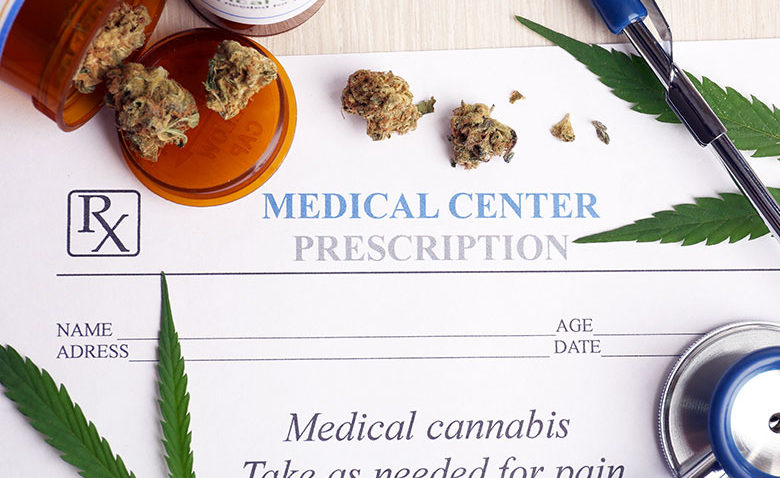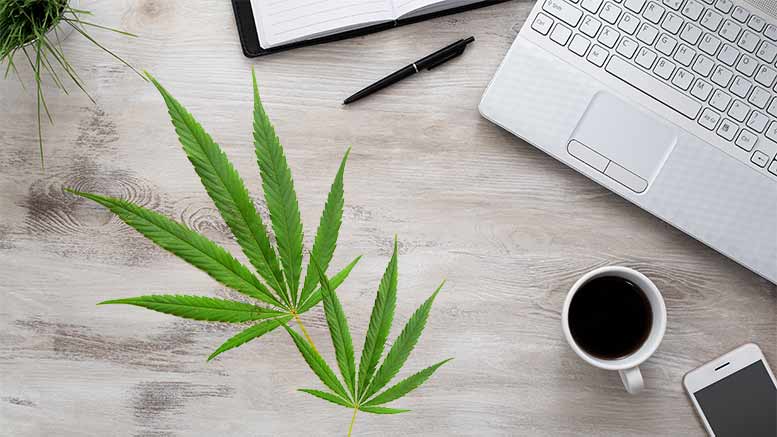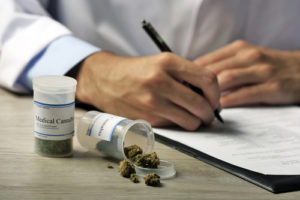Reported rates of marijuana use have more than doubled in the past decade. Marijuana is now legal in nearly half of US states and is increasing access to the drug for current and potential future users. Although it is often portrayed as harmless, and sometimes even therapeutic, there has not been nearly enough studies done to prove this. In fact, marijuana is often prescribed for issues like anxiety, though studies cannot comprehensively show this to be true. The current available information of the impact marijuana has on the neurophysiology of the brain show, predominantly, depressive effects.
In a recent study using pet imaging to demonstrate the release of dopamine in the striatum, a region of the brain that is involved in working memory, impulsive behavior, and attention, results showed that heavy marijuana use has similar dopamine releasing behaviors as cocaine and heroin. Several studies in chronic cannabis users show structural changes to the hippocampus persist, even after six months of abstinence.
U.S. Surgeon Generals have already warned that we’re too quick to legalize the popular drug when research still hasn’t shown whether or not it’s truly safe. With our new research, there is proof that concerns are well warranted.
Research finds that, after studying imaging of 1,000 cannabis users’ brains, there were signs of noticeable deficiencies of blood flow. The study, which included 25,168 non-cannabis users, and 100 healthy controls, shows a scary and obvious difference in blood flow levels for those that used cannabis. Additionally, those that used marijuana showed a significant lack of blood flow in the right hippocampus, the area of the brain that helps with memory formation. This part of the brain is severely affected with those that suffer from Alzheimer’s disease.
Our research has shown that marijuana users have lower cerebral blood flow than non-users. The most predictive region separating these two groups is low blood flow in the hippocampus on concentration brain imaging.This work suggests that marijuana use has damaging influences in the brain – particularly regions important in memory and learning and known to be affected by Alzheimer’s. Our research demonstrates that medical marijuana can have significant negative effects on brain function. The media has given a general impression that marijuana is a safe recreational drug, this research directly challenges that notion.
Several studies of perfusion imaging in marijuana users have shown similar results compared to ours. A small O15 PET study in a sample of 12 marijuana users used a randomized clinical trial design to examine brain perfusion before and after marijuana use. The study results found frontal, temporal and occipital lobe hypo-perfusion – all findings concordant with our study.
Who can legally use medical marijuana in Florida? Medical marijuana is a treatment option for Florida residents who have documented cases of Parkinson’s disease, PTSD, Crohn’s disease, glaucoma, AIDS/HIV, ALS, cancer, arthritis, multiple sclerosis, epilepsy, chronic pain, seizure disorders, muscle spasms or any similar debilitating condition. It is also available to people suffering from any condition determined to be terminal by two physicians. How do patients get a medical marijuana card? People 18 or older must visit one of the more than 1800 doctors who are permitted by the Florida Department of Health to recommend medical marijuana. Those under 18 are required to see two doctors. If a physician agrees that the use of medical marijuana has more benefits than risks, the patient is entered into the registry and can apply for an Office of Medical Marijuana Use ID card. Once the initial certification is issued, patients must be reevaluated by their physician once every 30 weeks in order to be able to have their certification renewed. Where is medical marijuana sold? Registered patients in Florida can take their doctor’s recommendation on one of the 29 licensed medical marijuana retail dispensaries to make purchases once approved by the state. Patients are allowed to purchase up to a 70-day supply at one time. Although federal law doesn’t allow marijuana to be sent through the mail, for patients who don’t live near a dispensary or can’t travel to one, most MMTCs deliver statewide. How much does it cost? An initial visit to a doctor to become certified generally costs around $300 with follow-up visits running at about $200. State ID cards from the Office of Medical Marijuana Use cost $75. What forms of medical marijuana are available?
Patient’s can buy marijuana & many other areas in what’s commonly known as “flower” form. Also, medical marijuana is delivered through vaporizers, pills, creams, transdermal patches, suppositories, oral drops, edibles or nasal sprays. It’s illegal to smoke any form of marijuana whether medical or recreational in Florida however there are many other uses.
Can people grow marijuana themselves?
With the exception of the state’s licensed MMTCs, growing marijuana is illegal in Florida. Even a registered medical marijuana patient will be charged with a felony and could serve jail time for possession of a cannabis plant.
Is marijuana a legitimate medicine?
Because the Food and Drug Administration has not approved the use of marijuana for any medical condition—landing it in the Schedule 1 category along with heroin and LSD—it is tightly controlled, and studies on its efficacy are limited. Current science supports the use of marijuana and many other states as a painkiller, anti-emetic, neuroprotectant and appetite stimulant. Ongoing research includes studies focused on pinpointing how it may affect certain body systems and disorders.
How does medical marijuana work in the human body?
The human body’s endocannabinoid system naturally makes marijuana-like chemicals that bind to receptors embedded in cell membranes in the liver, brain, lungs, kidneys, nervous system and immune system. When a patient uses medical marijuana, the chemicals in the drug are delivered to the blood through the lungs (when inhaled), the digestive system (when consumed), or the skin (when applied topically). When those chemicals interact with key endocannabinoid receptors, they can suppress signals such as pain, nausea and depression, while boosting signals of appetite and euphoria.
Is marijuana still illegal at the federal level?
Yes. However, the federal government hasn’t pursued criminal charges against people who sell or use medical marijuana within state registries. Because of the disconnect between federal and state laws, health insurance companies can’t cover medical marijuana, and doctors can’t prescribe it—they can only recommend it. Additionally, banks can’t accept deposits from cannabis companies, so patients must pay cash when they make purchases at dispensaries. Employers are allowed to fire workers who test positive for marijuana, even if they consume the drug as a part of the state’s registry.
At All Natural MD Florida marijuana doctors and cards we can help you and your loved ones overcome the stigma and suffering associated with cancer, anxiety, depression, weight loss, addictions, memory issues, brain fog, and other emotional, cognitive issues and a lot more. If you are ready to regain control over your life or help a loved one, give us a try.
References:
https://pro.psychcentral.com/the-neuroscience-of-marijuana/
https://link.springer.com/article/10.1007/s00213-014-3523-4
https://journals.lww.com/neuroreport/Abstract/2003/06110/Marijuana_alters_the_human_cerebellar_clock.9.aspx
https://jamanetwork.com/journals/jamaneurology/article-abstract/2604134
https://jamanetwork.com/journals/jama/article-abstract/645188
https://www.ingentaconnect.com/content/ben/cpd/2005/00000011/00000025/art00002
https://www.ncbi.nlm.nih.gov/books/NBK230711/
Related Articles:
Marijuana As An Alternative To Pharmaceuticals
Florida Marijuana Doctors are seeing more patients than expected
What forms of medical marijuana are available?
Patient’s can buy marijuana & many other areas in what’s commonly known as “flower” form. Also, medical marijuana is delivered through vaporizers, pills, creams, transdermal patches, suppositories, oral drops, edibles or nasal sprays. It’s illegal to smoke any form of marijuana whether medical or recreational in Florida however there are many other uses.
Can people grow marijuana themselves?
With the exception of the state’s licensed MMTCs, growing marijuana is illegal in Florida. Even a registered medical marijuana patient will be charged with a felony and could serve jail time for possession of a cannabis plant.
Is marijuana a legitimate medicine?
Because the Food and Drug Administration has not approved the use of marijuana for any medical condition—landing it in the Schedule 1 category along with heroin and LSD—it is tightly controlled, and studies on its efficacy are limited. Current science supports the use of marijuana and many other states as a painkiller, anti-emetic, neuroprotectant and appetite stimulant. Ongoing research includes studies focused on pinpointing how it may affect certain body systems and disorders.
How does medical marijuana work in the human body?
The human body’s endocannabinoid system naturally makes marijuana-like chemicals that bind to receptors embedded in cell membranes in the liver, brain, lungs, kidneys, nervous system and immune system. When a patient uses medical marijuana, the chemicals in the drug are delivered to the blood through the lungs (when inhaled), the digestive system (when consumed), or the skin (when applied topically). When those chemicals interact with key endocannabinoid receptors, they can suppress signals such as pain, nausea and depression, while boosting signals of appetite and euphoria.
Is marijuana still illegal at the federal level?
Yes. However, the federal government hasn’t pursued criminal charges against people who sell or use medical marijuana within state registries. Because of the disconnect between federal and state laws, health insurance companies can’t cover medical marijuana, and doctors can’t prescribe it—they can only recommend it. Additionally, banks can’t accept deposits from cannabis companies, so patients must pay cash when they make purchases at dispensaries. Employers are allowed to fire workers who test positive for marijuana, even if they consume the drug as a part of the state’s registry.
At All Natural MD Florida marijuana doctors and cards we can help you and your loved ones overcome the stigma and suffering associated with cancer, anxiety, depression, weight loss, addictions, memory issues, brain fog, and other emotional, cognitive issues and a lot more. If you are ready to regain control over your life or help a loved one, give us a try.
References:
https://pro.psychcentral.com/the-neuroscience-of-marijuana/
https://link.springer.com/article/10.1007/s00213-014-3523-4
https://journals.lww.com/neuroreport/Abstract/2003/06110/Marijuana_alters_the_human_cerebellar_clock.9.aspx
https://jamanetwork.com/journals/jamaneurology/article-abstract/2604134
https://jamanetwork.com/journals/jama/article-abstract/645188
https://www.ingentaconnect.com/content/ben/cpd/2005/00000011/00000025/art00002
https://www.ncbi.nlm.nih.gov/books/NBK230711/
Related Articles:
Marijuana As An Alternative To Pharmaceuticals
Florida Marijuana Doctors are seeing more patients than expected
Not all physicians can, or are willing to recommend medical cannabis for their patients. Our registration company has worked to find DEA certified physicians with the background knowledge, and expertise needed to perform Medical Marijuana Recommendations. The state has strict criteria for doctors who are willing to write Medical Marijuana Recommendations for patients. Your doctor must be an MD or DO, and DEA registered with no license restrictions or conditions. We pride ourselves in finding physicians who not only meet the state standards, but go above and beyond to provide unmatched follow-up care and medical resources to all of our patients. We want to provide you the best care possible and our doctors can help get your life back to where you want it to be. Make this process easy and let us take care of all your Medical Marijuana needs. When you see our doctor you must have a qualifying condition in order to receive a Florida Medical Marijuana Recommendation. Medical documentation is helpful but not necessary if you are over the age of 21. The condition must be severe and/or debilitating in nature or else the doctor cannot recommend Medical Marijuana. The physician will need to know certain things about your condition, how long it has been present? How was it diagnosed? How does is affect your daily life? What brought your condition about? Please have either medical records that document the answer to these questions present at your appointment, or know your past medical & alcohol history so you may give a concise and complete overview of your medical history.
You can qualify with PTSD, Depression, Anxiety, BiPolar, Chronic Pain and more. It is important that you have been seen by a medical professional for your condition at some point in your past. Your Florida Medical Doctor cannot diagnose your condition, but only evaluate it to determine whether Medical Marijuana is right for you. Once you see the doctor, our cannabis professionals will notarize your paperwork and will have your documentation ready to mail off to the state. Your marijuana license may take a while to be approved by the state. In the meantime, we can recommend dispensaries and caregivers that can take care of all of your Medical Marijuana needs. We only recommend state approved dispensaries that are discreet and professional. Dispensaries and medical professionals all over recommend us as your one stop to finding a medical marijuana doctor location in Florida and Registration Company because of our unparalleled service and care for our patients. Our doctors look forward to helping you achieve the highest grade of health through cannabis therapy. We look forward to you becoming a part of the All Natural MD community! Let us help you take the steps to living a healthy life through the use of Medical Marijuana.
A large group of All Natural MD marijuana cards and doctors, including a former surgeon general and faculty members at some of the nation’s leading medical schools, has formed the first national organization of doctors to call on states and the federal government to legalize and regulate the use of marijuana in the interest of public health. If you have one or more of the state approved conditions and the condition is chronic in nature, and/or is debilitating, call us today to set up an appointment! We can assist you in obtaining your state issued Medical Marijuana Card. Our physicians are DEA certified and state approved to help you qualify for a medical marijuana license in Florida. Once our doctors approve you for medical marijuana, our onsite notary will assist you in completing all state documentation necessary to officially become a Florida medical marijuana patient. We not only provide expert education on becoming an medical marijuana patient, but we also provide direction in finding a dispensary or caregiver that will best suit your needs. Contact our friendly staff today to learn what steps you now need to take to begin your medical marijuana treatment today.
A group is endorsing the legalization of marijuana for adult recreational use, a break from the position of the American Medical Association, the largest organization of doctors in the country. Citing hundreds of thousands of annual marijuana arrests, racial and economic disparities in marijuana enforcement, and the role of prohibition in keeping marijuana prices high and lucrative to violent drug dealers, the physicians say that creating a legal and regulated marijuana market is the best way to ensure public safety, combat the illicit drug trade and roll back the negative consequences of strict enforcement policies on disadvantaged communities.
The emergence of the group comes at a crucial moment in the national debate over marijuana legalization. More than 60 percent of the public now says that it supports marijuana legalization. Support for allowing medical use of marijuana with doctors’ supervision is closer to 90 percent. Over 35 million Americans use marijuana recreationally each year, according to the latest federal statistics. Many national lawmakers have called on federal authorities to revisit policies toward marijuana that have remained essentially unchanged for nearly 50 years in oppositions and researchers generally agree that marijuana use is less harmful to individuals and society than the use of other common drugs, like alcohol and tobacco, about 9 percent of people who begin using as adults become dependent on the drug, and heavy use can be especially harmful to the developing brains of adolescents. If you’re going to make something against the law, the health consequences of that use have to be so bad to make it worth creating criminal consequences. That was never true of marijuana.
Indeed, in 1977, the objected to the overly strict regulation of marijuana, as it was then used as a treatment for a number of medical conditions. The Association was worried that prohibition of marijuana would “deprive the public of the benefits of a drug that on further research may prove to be of substantial value.”
After the passage of the Marijuana Tax Act just wasn’t that well-known among doctors. Many doctors were unaware that the drug essentially outlawed by the Marijuana Tax Act was the same substance they knew as cannabis,” which they used to treat a variety of ailments from corns to poor appetite. In subsequent years, physicians were just as susceptible to lurid media reports about the supposed dangers of marijuana use and the “Reefer Madness” era as anyone else. Like most mainstream medical groups, many are now opposed to the outright legalization of marijuana, calling it a “dangerous drug” and “a public health concern.” But the group’s stance has evolved in recent years. It recently added language to its position statements calling for “the modification of state and federal laws to emphasize public health based strategies,” rather than punitive, incarceration-based measures. The group now encourages research into the drug, and has called on federal authorities to make it easier to do so.
Doctors often find themselves acting as mediators between patients who want access to marijuana for medical purposes, and a federal bureaucracy that still considers the drug illegal for all purposes.
Florida Medical Marijuana Doctors are put in the awkward position with respect to individuals who ask for a marijuana recommendation, but otherwise would be perfectly happy purchasing the drug in a retail environment,” Nathan said. “We believe that the best way to improve the situation is to enact full legalization with smart regulation. That would more clearly separate medical from personal use.”
Not all medical professionals are happy about relaxing attitudes toward what they see as a dangerous, addictive drug. The notion of doctors advocating for marijuana legalization is “totally idiotic,” who served as the first director of the National Institute on Drug Abuse. “The idea that we cannot manage the health problems related to marijuana because it’s illegal, that doctors are somehow inhibited from dealing with marijuana use and marijuana problems, is completely wrong.”
“The idea that legalizing is going to stop the illegal market is equally stupid,” he added.
Others thinks that the current legal status of marijuana is sufficient to address the risks associated with marijuana use, and that punitive measures for drug sellers and users can be a powerful tool for helping at-risk people get treatment. “The criminal justice system is a wonderful vehicle for getting people into treatment and recovery,” he said.
Other physicians would like to see marijuana use decriminalized, but would not go so far as to make the drug completely legal for adult recreational use. An addiction-medicine physician notes that we already have two legal psychoactive drugs, alcohol and tobacco. “What is the problem for which having a third class of legal drug is the answer?” he questioned.
Still, he points out that there’s a lot of diversity in the medical field. “People are of their time and of their culture and doctors are no different,” he said. “There are physicians who are Republicans, Democrats, Independents — they pretty much they reflect the population. There are all kinds. The fact that there’s a group of physicians now coming out in favor of cannabis legalization as the only effective way to regulate, it is no surprise.”
Much of the discussion around marijuana legalization, among doctors and the general public alike, hinges on different assessments of the same data showing the risks and benefits of changing marijuana laws. Groups like the are concerned that legalization would lead to more widespread use of the drug, which would invariably mean greater prevalence of the negative health consequences associated with its use, like dependency and some mental illnesses that may be exacerbated by the drug’s use.
But groups who favor legalization, point out that negative outcomes arise from the current system of prohibition, too. They say that the presence of a large black market, the stigmatization of individual users, and the potentially life-ruining effects of a marijuana conviction, are steep prices to pay for the nominal reduction in overall use that comes with prohibition. Get Started.
What Are The Different Ways To Administer Medical Marijuana?
What is Marijuana?
Marijuana, otherwise known as cannabis comes from the cannabis plant which has many
useful usages. The stalks can be used for paper, clothing, rope, and building materials, the
seeds can be used for food and fuel oil, and the whole plant, stalk, leaves, seeds, and
flowers can be used for medicinal purposes. Once mature, the plant’s leaves and flowers are
covered with trichomes, tiny glands of resinous oil containing cannabinoids and terpenes
that provide physical and psychoactive effects. There are many ways in which cannabis
leaves and flowers can be consumed.
Marijuana in the Medical world
Studies have shown that the use of medical marijuana has gained much more popularity in
the recent years. Medical marijuana can treat a range of different illnesses or symptoms
ranging from cancer effects, chronic pain control to treating insomnia. Although, it is not yet
legal in all states and countries there is a major support in this to be changed. With 11 states
now making medicinal marijuana legal and ongoing commissions for a further 5 states to
legalize it in 2020. Studies show that patients who were previously using opioids have
switched to marijuana with a positive outcome resulting also in a drop in opioid-related
deaths. Many people have started to lose faith in pharmaceutical drugs and want a more
natural way to treat their diseases/illnesses or problems and since cannabis/marijuana is a
plant this makes it a natural resource.
Additional Source: Administering Medical Marijuana Orally or Rectally
Different types of Marijuana
There are many types of cannabinoids and terpenes that are found in the marijuana plant.
– The most common and well-known cannabinoid is THC (delta-9-tetrahydrocannabinol) this
is the element of the plant which has the most significant psychoactive effects. The ratio of
THC to other cannabinoids depends on the strain of the plant you use.
– Cannabidiol (CBD) is the strain used to relieve anxiety, nausea, inflammation, and
convulsions without psychoactive effects. This is the strain that is mostly used in medical
marijuana since it does not give the ‘high’ sensation when used.
– Cannabinol (CBN) has a mild psychoactive effect and is usually used to decrease intraocular
pressure and to treat seizures.
– Cannabichromene (CBC) is mainly used when treating insomnia as it is a strain that
promotes pain relief and acts as a sedative.
– Cannabigerol (CBG) Is also a sedative and contains antimicrobial properties as well as
lowering intraocular pressure (pressure behind the eyes).
– Tetrahydrocannabivarin (THCV) Is still under research however is proving to be useful for
type 2 diabetes and other metabolic disorders.
Effects of Marijuana:
The effects of marijuana differ and there are other elements that contribute to the effect on
an individual. Each person reacts differently to a particular strain of marijuana and should
you find you react negatively to one strain does not mean that you would react negatively
to all strains. It can take some trial and error to find the strain suitable for you. To gain the
effect you desire you should consider the dosage, your experience and history of usage, your nutrition and diet, and also your mindset, mood when using. These factors will determine which effect the marijuana will have. Although, generally the effects are similar for qualifying medical conditions, eliminating pain and nausea control, appetite stimulation, reduced muscle spasms as well as improved sleep. It will depend on which strain you use as to how beneficial the effects are for you or your condition.
Different administrations of marijuana:
Since there are different strains of marijuana it goes without saying that there are also
different administration techniques and the best one for you will be determined by, the
comfort of use, strength desired, and the overall desired effect.
Edibles
For the cannabinoid to be effective it must be heated, you can implement the strain of
marijuana into food or drink sources which you heat before ingesting as this is known as edibles. For example homemade brownies, cookies, or cake with the marijuana as an added ingredient, special
tea brewed with the strain of marijuana present. By using the marijuana in this way, the
effects may take longer to show however they may last longer this is due to the time it takes
for the body to absorb the THC in the liver. Cannabinoids are fat-soluble hydrophobic oils
meaning that they are able to dissolve in oils, butters, and fats however, do not dissolve in
water. Depending on which strain you use and how much you include will depend on how
strong the effects will be from the edible made.
Cannabis Oil
Cannaoil is a cooking oil infused with cannabinoid this can be used within your cooking
routine providing the food you are making does not need to be heated over 280 degrees
Fahrenheit. The oil can be heated in any kind of pan over a low heat and then the cannaoil
can be extracted through a strainer.
Cannabis Butter
Cannabutter can be used in a similar way to that of the cannaoil. By heating the pure strain
of marijuana or cannabis together with some butter allows them to mix together which can
then be used in a cooking method.
Tincture
Tinctures use a mix of pure alcohol to extract the cannabinoid which can then be dropped
into the mouth by small amounts to be absorbed through the mucous membranes located
in the mouth.
Spray
Using the same method of tincture, the spray is combined with pure alcohol which is then
sprayed under the tongue to be absorbed by the mucous membranes.
Cannabis Topicals
These are creams made up of the cannabinoid strain which are applied to the skin. These
treatments are mainly used for external medical concerns. Medically applied cannabis creams have shown to treat allergic reactions, lessen inflammation, post-herpes neuralgia, and even muscle strain. Marijuana reacts with CB1 and CB2 receptors which can be found all over the body including in the skin cells. THC and CBD have both proven to be effective for pain relief and inflammation and by using the marijuana in a cream it has shown to have no psychoactive effects (meaning there is no ‘high’ with the user).
Smoking
The most obvious and well-known use of medical marijuana is via smoking. This is the way in
which the cannabis/marijuana plant is rolled into a smoking paper mixed with tobacco and
then smoked. By administrating the marijuana in this way you are likely to receive a fast
effect as well as getting the ‘high’. All Natural MD Marijuana Doctor.
It is important to remember that medical marijuana is still undergoing research for its
benefits versus negative effects, however, in saying that the negative seems to be very little
thus far. Working out which administration is best for you will more than likely be a trial and
error phase and if you are unsure where to begin you may want to speak to a professional
to get their opinion.
References marijuana study and research:







